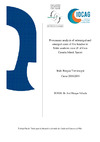Identificador persistente para citar o vincular este elemento:
https://accedacris.ulpgc.es/jspui/handle/10553/75528
| Título: | Provenance analysis of submerged and emerged sands of five beaches in Telde southern coast | Autores/as: | Burgoa Torrontegui, Iñaki | Director/a : | Mangas Viñuela, José | Clasificación UNESCO: | 251090 Geología marina | Palabras clave: | Beaches Sands Telde (Gran Canaria) |
Fecha de publicación: | 2019 | Proyectos: | Sistemas playa-duna actuales y fósiles en la costa de Telde: Registro de Cambios globales del nivel del mar en tiempos geológicos recientes ( Convenio de investigación 2018-2019 del Ayuntamiento de Telde-ULPGC-FCPCT) | Resumen: | The nature of thesubtidal, intertidal and supratidal sands of five beaches on the southern coast of the municipality of Telde (E of Gran Canaria) has been studied. Thus, the origin analysis of 29 sand samples has been carried out through petrographic studies of grain identification and point counting (200identificationsper thin section). The results confirm that there are two types of beaches, one with blackish dark sands (Salinetas) that is rich in volcanic terrigenous (fragments of rock and mafic and felsic minerals) and intraclasts, with a mean percentage of abundance of lithoclast 87.4% and of bioclasts 12.6% (σ = 5,6), being the fragments ofmafic rock and ferromagnesian minerals the most frequent. The rest of the beaches (Aguadulce, Ojos de Garza, Ámbar and Gando) show lighter beige colors as they are richer in bioclasts (with average values of 37.9% σ = 10.5, 30.9 σ = 5.1; 47.6% σ = 13.4,32.2% σ = 8.1, respectively), being the flora grains (rhodoliths) more abundant than those of fauna (mollusks and, to a lesser extent, foraminifera, echinoderms and bryozoans). There is no homogeneity of data between the submerged and emerged sands in each beach, so the coastal dynamics and the wind are not able to balance the values of abundance. Likewise, the variations found in the nature of the sands in these 5 beaches are due to different natural coastal geomorphological factors (for example, orientation of the beach line, presence of sedimentary and volcanic rocky, substrates and cliffs, existence of ravinemouth, etc.)and/oranthropic conditions (urban and natural beaches, different coastal management, etc.). | Departamento: | Departamento de Física | Facultad: | Facultad de Ciencias del Mar | Titulación: | Grado en Ciencias del Mar | URI: | https://accedacris.ulpgc.es/handle/10553/75528 |
| Colección: | Trabajo final de grado Restringido ULPGC |
En el caso de que no encuentre el documento puede ser debido a que el centro o las/os autoras/es no autorizan su publicación. Si tiene verdadero interés en el contenido del mismo, puede dirigirse al director/a o directores/as del trabajo cuyos datos encontrará más arriba.
Vista completaVisitas
77
actualizado el 10-ago-2024
Descargas
32
actualizado el 10-ago-2024
Google ScholarTM
Verifica
Comparte
Exporta metadatos
Los elementos en ULPGC accedaCRIS están protegidos por derechos de autor con todos los derechos reservados, a menos que se indique lo contrario.
